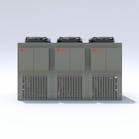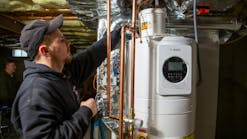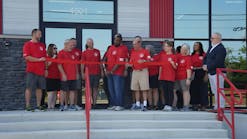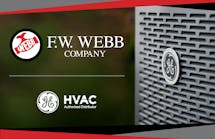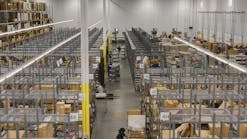It was 1983 when Sanyo HVAC Solutions entered the U.S. market with its ductless split systems. How would a Japanese company fare in this market where wholesalers and contractors had well-established relationships with HVACR manufacturers and ductless split was an unknown? Fast-forward 25 years, and it's clear that Sanyo has done quite well. In fact, the best is yet to come for this company that has become synonymous with quality ductless split systems.
Succeeding in the U.S. market has not been easy. It's taken the hard work of many people throughout the Sanyo organization. They've educated wholesalers, contractors and the architecture and engineering communities on the value of Sanyo and its ductless minisplit systems, while creating a seamless distribution system to ensure products and parts are on dealers' shelves, and they've cemented a reputation for superior customer service. Underlying all of this are the Sanyo products themselves. World-class is a description that many misuse and abuse, but it certainly fits Sanyo. After all, this is a company that can boast of many “firsts” in the HVACR industry worldwide: the first ductless split system in Japan and the first VRF system that offered simultaneous heating and cooling from one outdoor unit, among others. The world-class description also extends to its product quality, with Sanyo manufacturing the majority of its components, which provide a design that fits specific products, ensuring that the entire system works in harmony.
“These are truly engineered systems that are meant to work as proprietary systems,” says Michael McMurrough, national sales manager for Sanyo's split product line. “It means high levels of comfort and very low failure rates worldwide.”
Sanyo first brought its technology to the HVACR market in 1959 and built its reputation in Asia and then Europe before it entered the United States in 1983. Its ductless products have made Sanyo stand out globally, McMurrough says. “A lot of our success has come with the innovations that we brought out in ductless forms years ago,” he says. Although Sanyo made its reputation in ductless systems overseas, its challenge was to demonstrate its value to U.S. wholesalers and contractors.
Acceptance of the ductless systems in the United States has certainly come a long way. Thanks in no small measure to the education and training programs developed by Sanyo, split ductless systems are often the first choice among contractors on jobs. Once they discovered the ease of installing them and consumers remarked about their comfort, word spread.
“For the contractor, the biggest thing is high reliability and low labor content,” says Davis Watkins, vice president for Sanyo's Applied Products Division. “The technology is pretty much bulletproof. The labor pool among contractors gets tighter and tighter every year, and that stimulates growth for our segment — we are labor-friendly and predictable.” Sanyo products are about 90 percent complete when they arrive on a job site. “All a contractor needs to add are control wires and tubing,” he adds.
Sanyo HVACR products usually make their debut in Europe and Asia. Ductless systems are the norm: They've been in use for years in these countries, and they are highly efficient and compact, given the high energy costs and smaller living areas. The U.S. market benefits from the overseas introduction of products because Sanyo engineers will work out any kinks in the products before they hit here. Even with this delayed introduction, Watkins points out that Sanyo systems are still “10 years ahead of the curve when it gets to the U.S. The Japanese lead this technology.”
Failure rates for Sanyo HVACR products are less than one percent. “People associate our product line with a quality brand,” McMurrough says. “When they purchase a Sanyo ductless system, they're getting the highest quality system for the money, it's easily installed, and there are no callbacks.”
Sanyo systems also have the highest energy-efficiency standards built into the products, which is another benefit of having the products debut in the European and Asian markets. “The rest of the world does not wait for the government to mandate higher-efficiency products. Every part sourced by Sanyo is based on meeting the highest allowable standards,” McMurrough says.
The ductless segment in the United States has almost doubled in the past three years, according to McMurrough. This increased awareness of ductless systems goes right through to the consumers. Remodeling magazines, home renovation television programs and word-of-mouth have all piqued an interest among consumers. “Word-of- mouth is definitely one of the biggest contributors to this,” McMurrough says. “Someone will have one installed, and his neighbor will see it, and soon, they're having one installed.”
Sanyo has actively contributed to the growth of the U.S. ductless segment with an emphasis on education, technical training, and sales and service, so there is a complete understanding by wholesalers and contractors of the Sanyo products and ductless minisplits in general. Sanyo has a training center at its Kennesaw, GA, headquarters, and it has recently opened regional training facilities to broaden access to its resources.
While consumers are more aware of the HVACR options available to them, most of its marketing emphasis remains on contractors, who are still the greatest influencers on which HVACR system a consumer will purchase. “Contractors tend to gravitate toward the things that they're familiar with, and we're now at the point where contractors feel comfortable with our product,” McMurrough says. From the technology inside the ductless system and its installation to being able to sell homeowners on its features and benefits, contractors get ductless.
Sanyo has solidified its relationship with contractors by listening to their needs and then incorporating these needs into its products. McMurrough cites Sanyo's Flexi Multi split-system product, introduced two years ago after suggestions by contractors, that connects an outdoor unit to two to four indoor units. This system solves the problem of limited installation space while keeping the outside area free of clutter. Within this multisplit system are options for cooling only, a heat pump version and different sizes of condensers and indoor units. “There are 213 combinations that are available,” McMurrough says. “None of our competitors can match that.”
McMurrough says Sanyo has enjoyed a solid relationship with its distributors — many of whom have been with the company since 1983 — and they have been the key link to contractors. To better respond to the needs of contractors, Sanyo engineers now travel to Sanyo's U.S. headquarters every two months to work with its research and development team and salespeople to work on new ways to better meet U.S. market needs. Watkins says that there's a detailed process of validation to bring a Sanyo product from the idea stage until it's on the wholesaler's showroom floor, but, he adds, it's worth the wait. “If Sanyo decides to do something, it will come back and it will be a world-class product.”
Sanyo's ECO-i system is an example of the technology that creates world-class products. Designed for light commercial and residential use, they bill the ECO-i as an “intuitive system” that provides an immediate response to a change in a room's capacity, heat loads and varying sun exposure throughout the day. It establishes individual comfort zones allowing individuals in each office or room to adjust settings to fit personalized preferences.
ECO-i is the result of Sanyo's pioneering technology in variable refrigerant technology that allows the inverter compressor to speed up or slow down depending on the needs through a sophisticated control system, which provides the communication between the indoor and outdoor units. “All this is happening seamlessly with up to 40 indoor units,” Watkins says. “It's about our buildings and the way we live and use them.”
The ECO-i system is also advantageous for commercial use because of its flexibility. Commercial tenants come and go, and their needs change — walls come down, new ones go up in different places. Because the ECO-i is modular, requiring no ductwork throughout the building, the system shapes itself to the needs of the occupants. “This system was made for the living, breathing structures that are out there today,” Watkins says.
Sanyo is also popular among wholesalers because it offers the fullest and the most highly efficient line of HVACR products in the industry — from small 9,000 BTU single-split units to 25-ton ECO-i systems with SEER ratings ranging from 13 to 20. Sanyo also maintains three fully stocked distribution centers and parts warehouses strategically located in the United States that allow wholesalers to quickly access parts and equipment for their customers when they need them.
Wholesale distribution is vital to Sanyo's minisplit product lines, says Watkins. “In today's industry, a lot of people are trying to find quicker paths to market and trying to eliminate steps in the distribution channel,” he says. Sanyo long ago discovered that nothing beats the local support that a quality wholesale distributor adds to the value proposition. After all, these are not products for the do-it-yourselfer. “It needs to be purchased and installed by a licensed HVACR contractor,” McMurrough says. For engineered products like the ECO-i, design/build contractors may work in conjunction with a wholesale distributor, Watkins says.
Because Sanyo helped to usher in the minisplit systems to the United States, its people feel an obligation to ensure that its products perform and that its wholesalers, their customers and their customers' customers are satisfied. “We've been fighting battles for a lot of years to push this technology forward,” Watkins says. “Our people are driven. We're not the typical A/C guys, we're segment changers.” When Sanyo closed early on a Friday for a Christmas party, he recalls several people taking a break from the party to take care of a customer who urgently needed a part for the next day. “That's the kind of pedigree we've got,” he says. “These people are driven.”
As the minisplit segment has grown, new players have entered the market. McMurrough says there is concern that some of these new players provide lower-end manufacturing that could damage the reputation of minisplit systems that Sanyo has worked so hard to build. That creates new marketing challenges for the company. “We need to make sure that people understand what we are bringing to the table,” McMurrough says.
And that's where the wholesale distributor provides so much value. “We need them,” Watkins says. “We are not set up to do it any other way. That's why we're investing in supporting and growing our wholesale competencies, growing our training programs and, ultimately, growing their business.”
Michael Maynard is a business writer in Providence, RI, who writes on issues related to HVACR, construction and architecture. Contact him at [email protected].
Best Practice: “Think GAIA”
Definition and Example: Think GAIA is Sanyo's corporate mantra worldwide. GAIA, which translates to “Goddess of the Earth,” is a philosophy of treating the Earth as a living organism. This means that everything we take from or add to the Earth has an impact on it. The Think GAIA approach for Sanyo basically means that the company strives to be as earth-friendly as possible in all operations. From focusing on producing high-energy-efficiency products to manufacturing processes that strive to reduce waste and pollution, Sanyo is committed to keeping the Earth a beautiful place for generations to come.
Significance: By focusing on the Earth as a delicate resource, Sanyo strives to provide consumers with products that reduce electric consumption, enhance the quality of life and, most importantly, lead their respective industries in advancements in technology, energy efficiency and functionality. Sanyo is one of the world's largest producers of solar panels and photovoltaic cells, one of the world's largest rechargeable battery producers and a significant player in the high-efficiency appliance and air-conditioning businesses worldwide. Their core products are only a part of the GAIA approach to business. From business cards printed on recycled paper to reducing energy usage at their corporate offices worldwide, Sanyo is committed to being a responsible citizen of the Earth in all aspects of their operations.
Benefits: From air-conditioning systems that reduce electric peak load demands by utilizing inverter “soft start” technology and then run efficiently at part load conditions, to their Eneloop rechargeable batteries that can be recharged up to 1,000 times (reducing disposal concerns and new production needs), Sanyo's products deliver a high value content to their consumers. And they help consumers make good choices related to the Earth and its environment.
Procedure: From product inception to production, we always give full attention to extending energy efficiencies and lifecycles. We even constantly evaluate current product offerings for potential improvements in these areas. Sanyo's philosophy in manufacturing is to always strive for the highest in technology and value content.
People involved: Quite simply, every person that works for Sanyo as well as any vendor partners are positively encouraged to adhere to the global vision of Think GAIA.
Timing: Ongoing.
Cost: Obviously, producing high-efficiency and long-lifecycle products has a price premium. But not doing so has a much more significant cost to our quality of life, both now and in the future. Plus, in the long run, a premium product will typically offer a better value for the price than an inexpensive one.
Other considerations: Sanyo HVAC Solutions is celebrating its 25th anniversary in the United States this year. Since 1983, they have been committed to bringing the U.S. contractor a high-quality product that helps them solve their customers' needs. Sanyo will continue to introduce HVACR products over the years that offer leading technologies and support their vision of Think GAIA.
Contact: Mike McMurrough, national sales manager, 678/905-3078,
[email protected]
Toshiaki Inoue
Hirohisa Katoh
1062 Thorndale Avenue
Bensenville, IL, 60106
1690 Roberts Blvd. NW, Suite 110
Kennesaw, GA, 30144
